5th Grade Social Studies is where it’s at, my friends! In this blog post, I will share how I sequence, plan, and make social studies fun for my students.
I’m fortunate to have found my niche early in my teaching career and now I want to pay it forward by sharing my knowledge with you!
I often have teachers ask how I teach fifth grade social studies, in terms of sequence, pacing, and resources, so I am going to lay it all out for you in this blog post!
You’ll see links to the resources that I use in my own classroom throughout the year and you’ll see blog posts that will be helpful as you plan your year in social studies.
This sequence and pacing guide only tells you the order of my 5th grade social studies units and the time I spend on them. Reading my blog posts will give you all of the details and loads of ideas for teaching each unit.
Don’t let this overwhelm you!
I have been teaching this subject for so long that I know exactly what I am teaching and when.
If this is too much information for you at one time, I recommend that you scroll to the bottom of this post and have the pdf version of this blog post sent to you. You can use the pdf to plan your monthly social studies content!
Finally, I would like for you to keep in mind that there are ways to make social studies engaging for students that have nothing to do with papers and pencils.
Please read the following blog post to learn ways that I bring social studies to life in my classroom:
How to Make Your Social Studies Lessons Come to Life for Students
My Sequence and Pacing for Teaching 5th Grade Social Studies
School years in Oklahoma run from August to May but I know there is a great deal of variation throughout the country, so I arranged my sequence and pacing into months.
1st Month of School
We start school in the middle of the month, so I only have two weeks to teach during the first month of school.
This is the rundown for the remainder of the month:
Month 1, Week 3
Classroom Procedures – I recommend you check out this blog post: 5 Tips for Establishing Procedures in the Upper Elementary Classroom
Welcome Activities – Welcome to 5th Grade: First Week of School Activities
We set up interactive notebooks together, including the table of contents, cover page, and an About the Author page.
I introduce primary sources and lead students in some simple exercises to help them recognize the differences between primary and secondary sources.
This blog post contains some helpful tips for teaching with primary sources:
Teaching with Primary Sources in Upper Elementary
Month 1, Week 4
It is vital to continue teaching and reinforcing procedures this early in the school year! Teach it right or teach it all year!
I teach the Lost Colony of Roanoke during this week. My students usually report later that learning about the lost colony was one of their favorite topics. I recommend that you check out the following blog post and resource:
Teaching the Lost Colony of Roanoke (There’s a free cloze passage to download at the end of this post. I use it for morning work after students have learned all about the Lost Colony.)
Lost Colony of Roanoke Bundle: This resource includes a PowerPoint to introduce Roanoke, an interactive notebook lesson with foldables, and an engaging activity pack.
2nd Month of School
Month 2, Week 1
I teach the Salem Witch Trials during this week. The trials are not in my curriculum but my students are fascinated with this short time in history AND teaching about this time period helps students to get an inside look at the religious attitudes of the New England colonists that they’ll encounter later.
Students are shocked to learn that there was actually nothing evil or sinister about the Salem Witch Trials.
Salem Witch Trials – Sensational History Snip-Its Series
Teaching About the Salem Witch Trials in Upper Elementary
I spend most of the week on the Powhatan Indians. We talk about their culture and we look at some of the primary sources created by John White during his 16th Century study of the Virginia Indians.
I have never created a resource using these primary source images because the Native Americans portrayed are often in some state of nakedness. I have a PowerPoint that I use to show students the primary source images and I simply covered the questionable parts with shapes. Images are readily available on the Library of Congress website and you can make your own decision about using them in your classroom.
Month 2, Weeks 2-3
Jamestown/Powhatan Indians
I could spend an entire month on Jamestown but I have to move on at some point 🙂
Teaching About Jamestown Settlement (There’s a free Jamestown Anticipation Guide at the end of the blog post that I use when introducing the unit.)
Jamestown Unit – This is a comprehensive and engaging unit!
Month 2, Week 4
This week is all about Plymouth (Plimoth) Plantation. You may wonder why there are two different spellings. It’s because the original settlers used the Plimoth spelling to name their settlement. I’ve had so many teachers point out my “misspelling” of Plimoth, so I like to be upfront about the reason I use the original spelling.
This unit includes discussion of the Mayflower, Wampanoag Indians, Pilgrims, and plenty of primary sources!
Plymouth (Plimoth) Colony Unit
Trust me, you will want to check out the following blog post. I’ve included lots of great ideas here:
Teaching About Plimoth (Plymouth) Plantation
3rd Month of School
Month 3, Week 1-2
I introduce Colonial America with these free layer books. The layer books provide a great overview of each colonial region. You can grab them for free here: Colonial Regions Layer Books
I teach the 13 Colonies in regions, including the New England Colonies, Middle Colonies, and Southern Colonies.
Once students have completed their layer books, we start our unit on the New England Colonies.
This region is much different than the others because of the conservative influence of the Puritans.
Month 3, Week 3
This week is all about the Middle Colonies. This region was special because they had awesome soil and weather which allowed them to grow an overabundance of grains, leading to their nickname, The Breadbasket Colonies.
The Middle Colonies were also known for their religious freedom and toleration thanks to the influence of the Quakers.
Month 3, Week 4
I could spend months on the Southern Colonies but I must control myself. Haha!
There are so many activities that go along with the Southern Colonies.
This region was the powerhouse of the colonial economy. They grew cash crops, including tobacco and cotton, on small farms and large plantations.
While teaching about the Southern Colonies, I include a short study of colonial money, specifically pounds, shillings, and pence. The following blog post will guide you through this fun study. Be sure to snag the primary source freebie at the end of the post!
Teaching About 18th Century Colonial Money
This print ‘n go resource includes activities and primary source investigations: Colonial Money
Finally, the Southern Colonies depended on enslaved labor. I teach this subject delicately and with respect. I invite you to check out these blog posts to help you teach the difficult topic of slavery:
How to Teach 18th Century Slavery in Today’s Classroom
Teaching Slavery in Upper Elementary: An Interview with Scholar Richard Josey
4th Month of School
Month 4, Week 1
Southern Colonies, continued 🙂
I spend approximately two days helping students to review the colonial regions and compare/contrast the regions.
I think it is important to have students look closely at the similarities and differences in the regions because that will lead to deeper understanding.
I use this resource: Compare the Colonial Regions Activity Pack
Month 4, Week 2
Right after we finish learning about the 13 Colonies, I assign the first research project of the school year. I ask pairs of students to choose one of the thirteen colonies and complete the research project together.
I find that it’s helpful for my students to complete their first research project in class so that I am there to help and guide them.
This blog post lays out my method for teaching the research report process:
The Step-By-Step Guide to Teaching Research Reports
I use this step-by-step resource to guide students through the research process:
Research Report Instructional Unit
Month 4, Weeks 3-4
Oh, how I love teaching the Road to Revolution! The events that led to the American Revolution are full of drama, excitement, and intrigue.
Be sure to set up some sort of tracking display to help your students keep track of the events as you introduce them.
This blog post includes my best tips for teaching the Road to Revolution! Also, the tracking display that I use is pictured in the blog post.
Blog Post: Teaching the American Revolution in Upper Elementary
Road to Revolution: The Colonies Unite – An Active, Engaging Unit
5th Month of School
This is where our Christmas break falls, so I only have two weeks to teach this month.
We do some review of what we’ve learned so far and complete some activities and projects we haven’t had time to do previously in the year.
This month is a fantastic time to complete a family interview project!
This blog post will give you more information on how to complete this project with your students:
How to Assign a Family Interview Project
If you’re looking for a print ‘n go resource, click on the link below:
Interview a Family Member Research Project
6th Month of School
Month 6, Week 1
This week is devoted to finishing the Road to Revolution.
Month 6, Weeks 2-4
It’s finally time to start the American Revolution!
I can’t tell you how much I love teaching this unit!
Please check out the second part of this blog post to find out how I teach the Revolution:
Teaching the American Revolution in Upper Elementary
I use every single page of this comprehensive resource: American Revolution Unit
I do spend a little extra time on the Declaration of Independence because it was such a critical, groundbreaking document. This blog post will help you to teach this document in an engaging way!
Teach the Declaration of Independence the Fun Way!
No study of the American Revolution could possibly be complete without learning about spies!
The Continental Army won the Revolution because of George Washington’s genius spying techniques!
My students LOVE this activity pack: Spying in the American Revolution
Also, I do include a STEM project that ties into the American Revolution. Check out this blog post for the details:
Engaging American Revolution Interdisciplinary Project: STEM, Reading, Writing, and Art
7th Month of School
Month 7, Week 1
After students have learned all about the American Revolution, I start the Constitution.
The Preamble to the Constitution, in my opinion, is the best place to start because it presents the reasons our Constitution was created.
This blog post about teaching the Constitution covers the Preamble, Branches of Government, and Bill of Rights:
Tips for Teaching the Constitution in Upper Elementary
Because I usually spend only two days on the Preamble to the Constitution, I use the remainder of the week to start my instruction on the Branches of Government.
Comprehensive Constitution resource (includes Preamble, Branches of Government, and Bill of Rights):
Month 7, Week 2
This entire week is devoted to teaching the Branches of Government.
I do include lessons on checks and balances and separation of powers.
The lessons in the following resource are very detailed and specific to each branch, so I use this resource with my higher-level students:
I encourage you to check out the Judicial Branch Simulation. It is definitely a student favorite!
Month 7, Week 3
This is one of my very favorite weeks of the entire year!
I love teaching the Bill of Rights. My students get soooo into this topic.
They love to compare the Bill of Rights with current events happening in our city, state, and country.
I put my best advice on teaching the Bill of Rights in this blog post:
How to Make the Bill of Rights Applicable to Students’ Lives
I actually use several resources to teach the Bill of Rights, but I will just list my three favorites below:
Bill of Rights Interactive Notebook Pack
Bill of Rights in Everyday Life
Bill of Rights – How Important Are Our Rights?
Month 7, Week 4
During this week, we finish up our study of the Constitution and complete any remaining projects.
8th Month of School
Month 8, Week 1
During the 8th month of school and after, we have field trips and school events, so I don’t plan as much.
I do teach the Northwest Ordinance (1787) during this week.
The Northwest Ordinance (1787) – An Interactive Notebook Lesson
Month 8, Week 2
The Louisiana Purchase is fun to talk about with students.
I notice that most of them have usually heard of Sacagawea but don’t really know about her significance in American history.
This resource usually takes most of the week to complete and students think all of the activities are fun!
Month 8, Weeks 3-4
The Civil War is a fascinating, intricate topic in 5th grade social studies and it fits well at the end of fifth grade social studies.
I follow this resource and teach each lesson. There are primary sources included with most of the lessons, so students get a good deal of exposure to the historical period.
9th Month of School
This is our month of standardized testing, so I do a lot of review activities, Liberty’s Kids videos, and group activities.
I keep this month light and fun because students are stressed out about testing.
10th Month of School
We begin the month with this amazing project: Expert Historians Project and Presentation.
I give students approximately a week in class to work on this project so that I am available to help with questions and finding sources.
We make it a big deal and invite parents for the presentation part.
Please check out this blog post to find out more about the Expert Historians Project:
“Expert Historians” – An Engaging Research Project for Students
For the remainder of the school year, we connect the history that we learned this year with our modern world. I do this through newspaper explorations, internet scavenger hunts, and group art projects.
How do I set up a single day in my 5th grade social studies class?
When planning single days, I usually follow this pattern:
- Quick question or puzzle on the board for students to answers
- Lesson and guided practice
- Interactive notebooks and/or hands-on activities
- Exit tickets with evaluation or opinion question(s)
What do I sprinkle in throughout the year to enrich my 5th grade social studies lessons?
I do include other things throughout the school year that could be a bit redundant if I included them above, so I made a section of ideas and resources you might be interested in:
History Snip-Its Series – These are fascinating stories your students (and maybe you) have never heard. Bring history to life in your classroom by adding some dimension to our founding fathers (and mothers), historical events, documents, lifestyles, and people!
I created this series because I began to think about the many historical places and teacher workshops I’d been to and the fascinating things I have learned over the years as a history teacher. Some of these things just don’t fit into my traditional units, so I have decided to offer them as short history snip-its.
Sensational History Snip-Its Series Bundle CLICK HERE TO VIEW RESOURCE!
Primary Source History Stations – These stations are unique because they allow students to explore primary sources in a guided, engaging way. Students will learn more about historical people, events, and traditions than they could ever learn from a textbook!
Sons of Liberty: Primary Source History Stations CLICK HERE TO VIEW RESOURCE!
Children’s Literature books – There are loads of picture books that are perfect to include in your 5th grade social studies class. My students enjoy the times that I read books to them and I’m sure your students will also. I listed my favorite books to include with each unit in this post:
My Favorite Read-Aloud Books for Upper Elementary Social Studies CLICK HERE TO VIEW BLOG POST!
Pre-Contact Native American Groups: Although pre-contact Native American groups are not included in my state’s mandated curriculum, I feel that it’s important to learn about these groups, so I do sprinkle these units into extra times throughout the year.
Blog Post: Teaching About Native American Cultural Groups with Respect and Sensitivity
Resources: This link will take you to my Native American Units.
Journal Writing – I ask my students to write journal entries on what we are learning in social studies twice per week. Writing helps students to process information and decide what they think about it.
I have a surprise for you! I created a pdf version of this 5th grade social studies blog post that is conveniently hyperlinked to the resources and blog posts that I recommend. Simply enter your name and email address to have this pdf sent to you immediately!
The following bundle contains all of the resources mentioned in my blog post! ** If you are on the fence about buying the bundle, just know that every time I add to this blog post, I will add to the bundle as well. You’ll be able to download the new resources for free! **
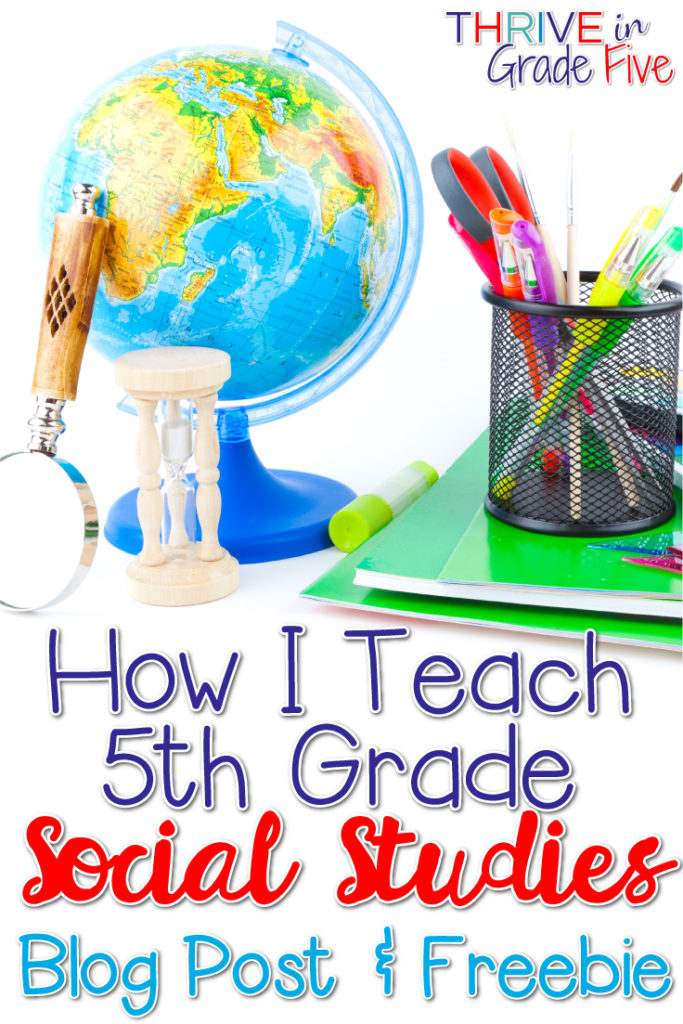
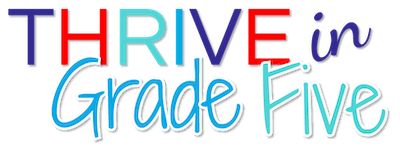
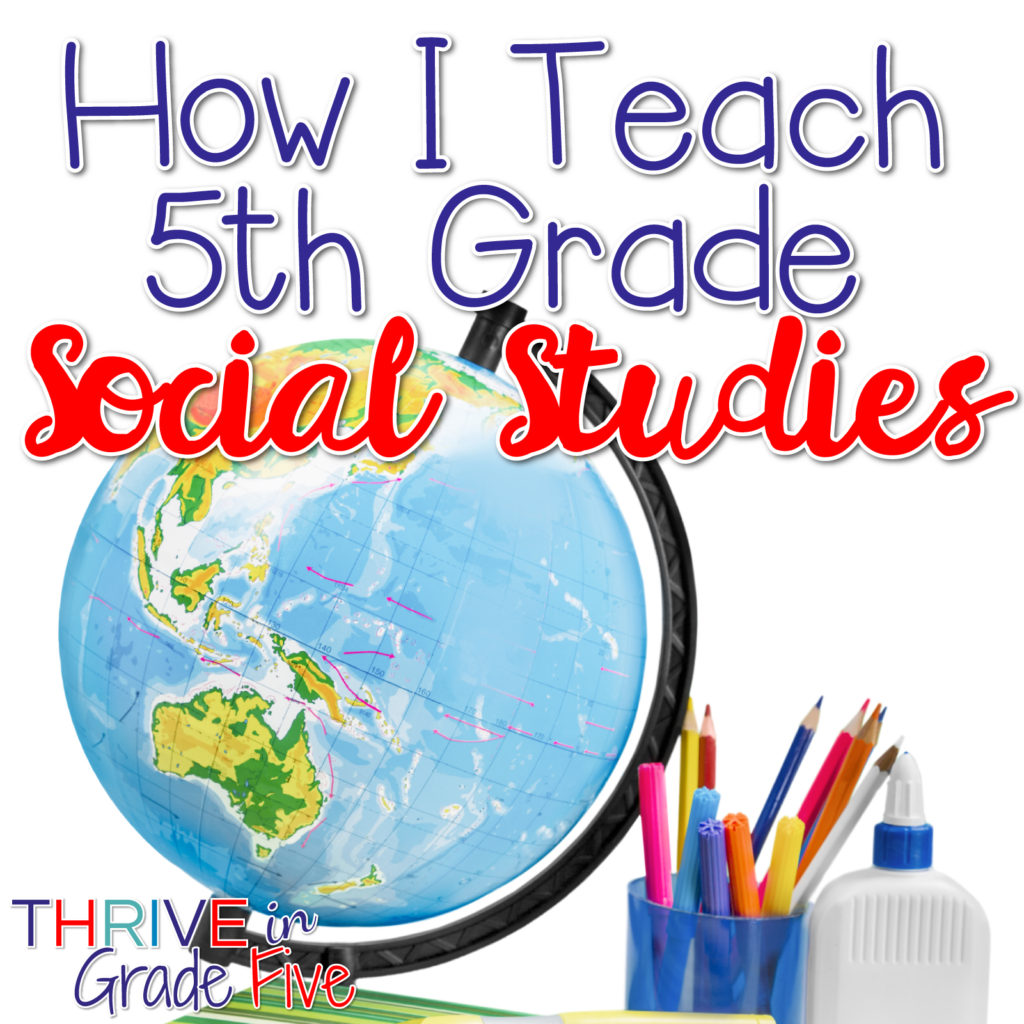
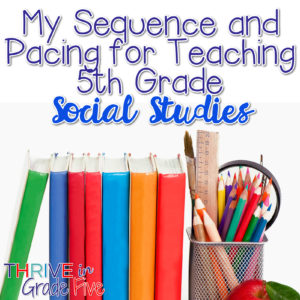
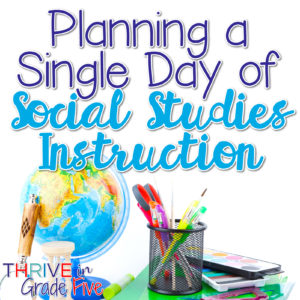
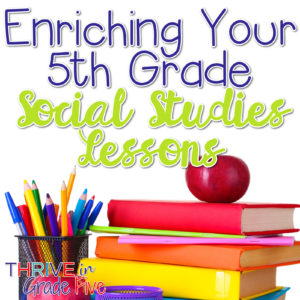


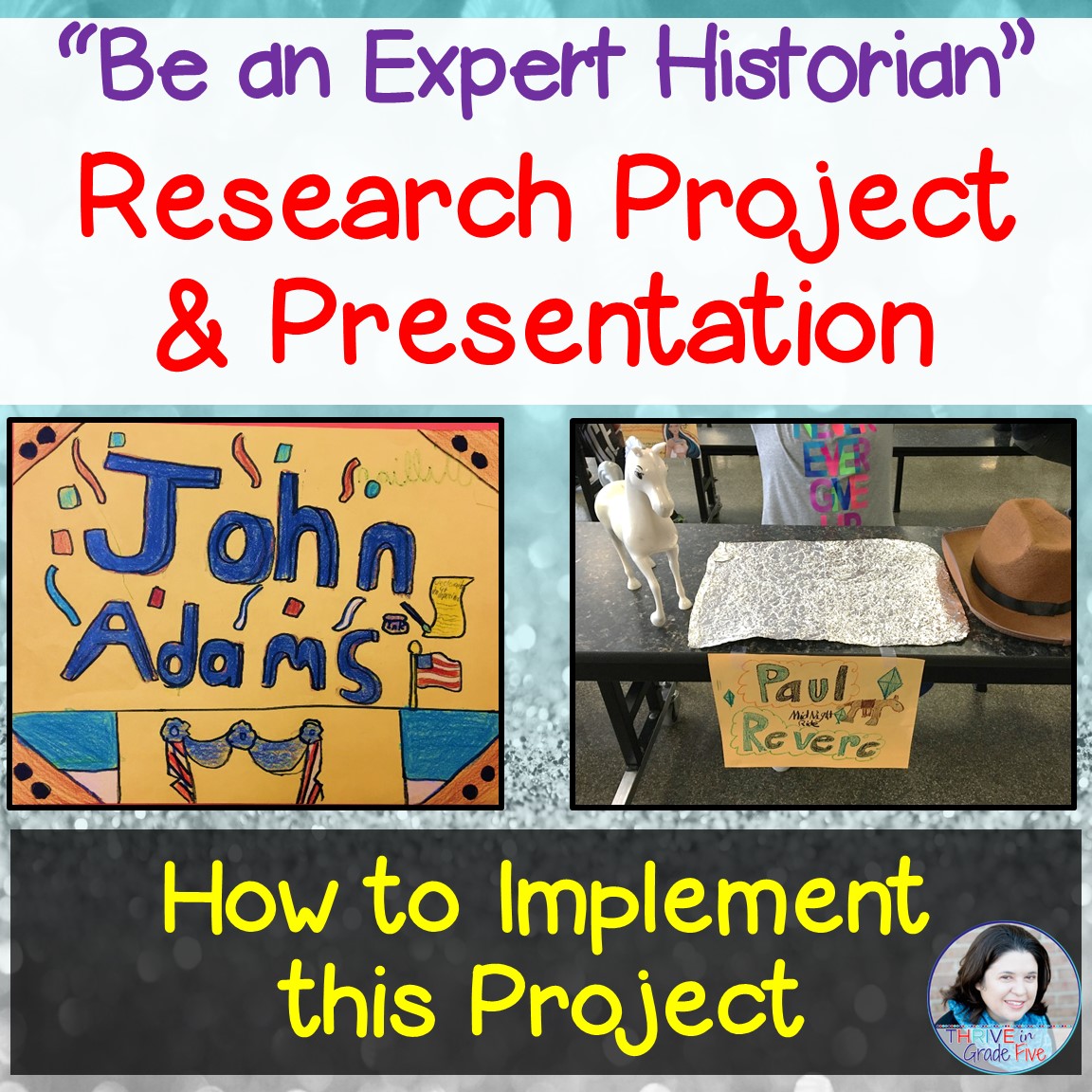
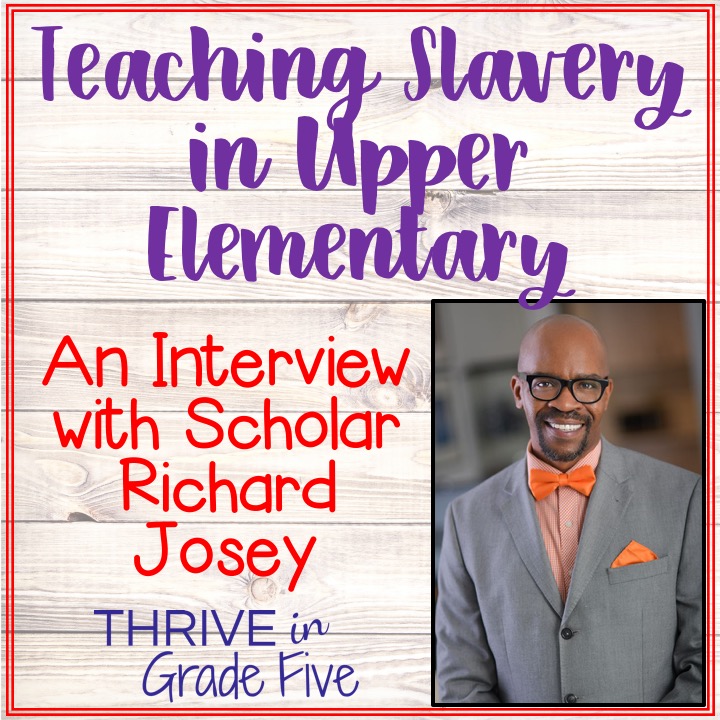



25 Comments
I would love a copy of this blog post, but there’s no place to enter information.
Thank you!
Kathy
Hi Kathy! I’m so sorry about that. There was a little bubble in my technology and the form didn’t show up. The form should appear in the next few minutes! Please email me at jenifer@thriveingradefive.com
Thank you. This will be so useful.
Do you have a one stop shop for every unit you have included in your social studies curriculum and placing guide or is it all separated by topics?
Hi Danielle! Thanks for reaching out to me! I don’t have all of the resources in my pacing guide combined into one bundle but that’s a fantastic idea. I will make something like that soon! This is the link to just my social studies resources:
https://www.teacherspayteachers.com/Store/Jenifer-Bazzit/Category/Amazing-Social-Studies-Resources-210422
Hello!
I too would love to see a unit bundle with all the mentioned resources from this blog post! Your outline and resources are making me look forward to teaching social studies next year!
Hi Miranda! I just created a bundle with all of the social studies resources in my blog post! Here’s the link: https://www.teacherspayteachers.com/Product/5th-Grade-Social-Studies-Big-Bundle-4438576
Can I say how much I love your blog posts? I teach upper elementary history and I have found so many wonderful resources on your blog pages. I literally cannot stop reading them!!!!! Thank you fir taking the time to share this very practical information! I can’t wait to start using this in my class!!!! We are starting the Revolutionary War thus week 😊
Thank you for your comment, Heather! It makes me so happy to know that I am helping other teachers 🙂
I taught 5th grade Social Studies for 25 years. You are lucky as I was to teach a great subject. It was so much fun for me to dress the kids up in costumes to make history come to life.
25 years? That’s amazing! I love that you let your students dress in costumes 🙂 How fun!
Wow! I am so happy that I came across this blog post and all your resources on TpT! I have several questions…
1. I am wondering about your use of interactive notebooks… do you have students glue in each of the informational text articles for each lesson into their notebooks in addition to the activities? That way it kind of serves as a “student-created” textbook/resource?
2. I am planning to buy the American Revolution bundle for this year, but am curious if I decide next year to buy the entire $143 bundle with all the resources from this blog post, if there is a discount? Sorry if that is a tacky question, I just want to try out a unit before investing so much in an entire year.
Thanks!
Hi Miranda! Thanks for reaching out to me! Here are the answers to your questions:
1. On my interactive notebooks, I do have my students glue the informational articles on the left side of the notebook page and I have them put the foldables on the right side. I love using the interactive notebooks as a student-made textbook.
2. If you buy the American Revolution Bundle and later decide to buy the big bundle, all you have to do is contact TPT customer service on the “Help” button at the top of the screen. They will refund you for the difference from what you purchased and what you paid for the big bundle! Not a tacky question at all! I hope you enjoy the American Revolution bundle. It’s one of my very favorites 🙂
Thank you!
OK has new standards for 2019. Do any of the bundles include the stamp act or the Boston tea party? This is my first time teaching 5th grade SS and our text books are beyond old. Im searching out alternative curriculum. Does the bundle cover ALL the standards?
Hi Bobbi! I love hearing from fellow Oklahoma teachers. I created most of my social studies resources to replace my old, outdated textbooks, so I completely understand where you’re coming from. I have reviewed the new 2019 Oklahoma 5th grade social studies standards and I can confirm that every standard is covered in my big bundle. The only exception is 5.3.4, the Iroquois Confederacy standard. That one is brand new, so I’ll be creating a new resource to cover that standard soon. I will add it to my big bundle when I get it posted. Please reach out to me at jenifer@thriveingradefive.com if I can help further!
Here is the link for the bundle I referenced in this comment: https://www.teacherspayteachers.com/Product/5th-Grade-Social-Studies-Big-Bundle-4438576
Hi Jenifer!
I LOVE your site! I will be teaching 5th grade Social Studies this year and have been looking for great resources. I found everything I need right here. Thanks so much for all your work and for all that you share with other teachers!
You are so welcome, Kelli! I’m so glad you found me. I wish you the best for the new school year! 🙂
I’ve just loved all of your posts and ideas since I’ve found you! I would appreciate the pdf version of this blog post that is conveniently hyperlinked to the resources and blog posts that you recommend. I have entered my name and email address to have this pdf sent tome. Thank you much!
Debbie Salcido : )
Hi Debbie! Thank you for your kind words and for requesting the pdf version. Email me at jeniferbazzit@yahoo.com if I can help you further 🙂
I am not joking when I say you may have just saved my sanity. I’m a fifth grade science teacher who has been teaching all subjects, remotely, since the beginning of the school year. I have enough background in language arts and math to make things work, but social studies has been the bane of my existence (My district decided that this year was a good year to “change things up,” so the middle school social studies teachers have been tasked with deciding what to teach and when. Luckily they’re all awesome, and have helped me limp through thus far.). Thank you, thank you, thank you for these awesome resources!!!
You are so welcome, Jenn! I love that I helped to save your sanity 🙂 I hope you start to love social studies! Best of luck for the rest of the year!
How long is your social studies block? I will have 30 minutes a day so I’m wondering how much I’ll be able to fit in.
Hi Jasmine! I have 50 minutes per day, 5 days per week to teach social studies usually!
I am so excited to dig into your social studies information! I have taught math for 20 years and this year will be doing social studies and science! To say I am lost would be an understatement; however I am excited for my new journey! Any guidance is greatly appreciated!
Thank you for taking the time to share your thoughts, Carla! I think you’ll do amazing 🙂